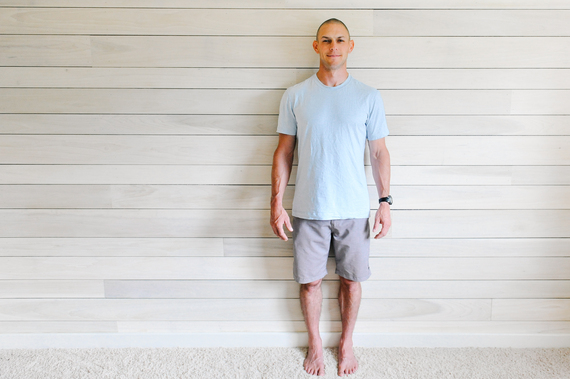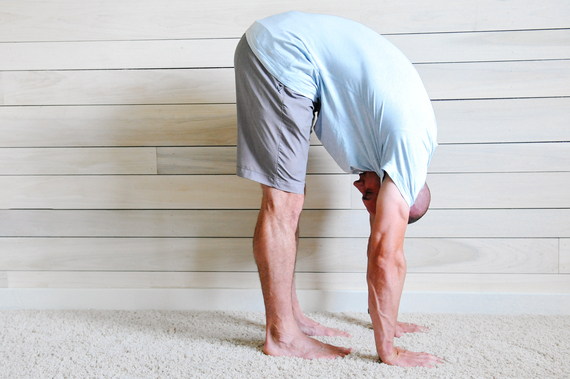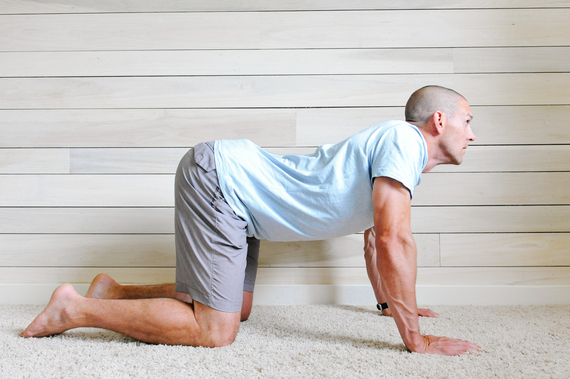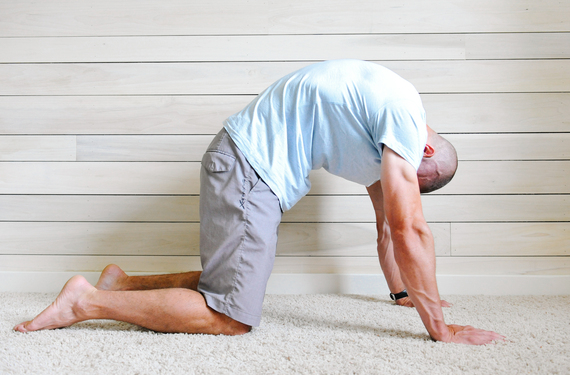By Brian Sabin
Just about every gym in the world is lying to you. The lies are told subtly. They aren't even spoken aloud. But they are often written all over the walls. The lies are well intentioned, aiming to show you the "right" way to exercise. We're talking about the posters that show someone properly performing a lift like a squat or bench press. In the picture, a sketched person executes the move flawlessly with perfect form. Various muscle groups are colored in, indicating which parts of the body fires up with this move.
You can do this, they tell you. Just follow these steps.
The problem is that your body probably won't allow you to do what's shown on the poster, according to Pete Egoscue, Sonima's advisor and posture therapist whose methods are taught at more than 25 clinics worldwide.
"I would venture to say that less than 10 percent of people applying themselves to some kind of weight training are able to recruit those muscles in that way," says Egoscue. "The charts assume function, balance, and postural correctness. They assume people who come to the chart are going to be able to use the muscles that are shaded based on the exercise."
Fewer and fewer of us possess those attributes and abilities, Egoscue says, thanks to a full-court press of an increasingly sedentary lifestyle, modern comforts, and the typical injuries and changes that occur in our bodies as we age. Other medical professionals add that even the activities we do to be fit, such as running, can lead to changes in the body that over time restrict its ability to move properly.
When we come to a training session with a body that has unsound posture, or that is limited in its range of motion, we simply won't be able to perform the exercises as they were designed. Instead, we'll compensate. This makes those moves less effective at producing the results we want. Worse, our imbalances and misalignments can increase our risk of injury during a workout.
In many cases, the postural issues that affect our movement are correctable. However, too many of us unnecessarily put ourselves at risk because we aren't even aware that we have a problem. We don't notice that our feet are pointing out to the side rather than straight ahead, or that our head and shoulders are leaning forward. We don't know that the right foot is carrying much more of the body's weight than the left foot, or vice versa.
"Eighty percent of adults in my experience do need to modify something in their exercise routines because of some type of musculoskeletal ailment," says Nick DiNubile, M.D., an orthopedic surgeon and author of four books, including Framework: Your 7-step Program for Healthy Muscles, Bones and Joints. "We all have weak links. I think that we have to fortify those links. Find out what they are, and then work to try and improve them."
For people who have postural issues, DiNubile cautions that some are caused by permanent structural abnormalities, adding that the mobility in his own upper back is restricted by a spinal injury he suffered years ago. "But most of them are not that way. Most of them you can correct -- especially if you're younger," he assures. "For most people, it's postural re-education that they need to do."
Postural re-education, DiNubile explains, is a process of finding your imbalances and then working to improve them. If you notice a tight spot, you work to improve mobility in that area. If you discover that one side of your body is weaker relative to the other side, you try to rebalance the area by building strength.
Related: How to Get to the Root of Elbow Pain
DiNubile and Egoscue agree that the first step is awareness. You have to know what the problems are before you can fix them. And while a medical professional such as a physical therapist or chiropractor will have a deep level of knowledge as well as powerful resources such as an X-ray machine, you can gain a lot of insight into how your body is performing through a simple self-assessment.
Try This Two-Minute Test at Home
Egoscue suggests that you start with an easy balance test. Find a mirror, take off your shoes, stand in front of it in your bare feet and observe:
How are you carrying your body weight? Close your eyes and take note of how your feet feel. Egoscue suggests you should feel that the weight is divided evenly between the left and right foot with most of it carried by the balls of the feet. "If you have range-of-motion design capability, that is where your weight is because we are symmetrical bipeds by design," he says.
Which direction are your feet pointing? Your toes should point straight ahead, Egoscue says. While that may be ideal, DiNubile notes that the direction of your toes depends greatly on the alignment of your femur (the large bone in your upper leg), which he says usually is set by about age 10. For now, simply notice the direction of your feet, and if necessary, adjust them inward as much as is comfortable.
Where are your hands? Egoscue says your hands should be at your sides, not in front of you, and you should be looking at the back of your thumb. You shouldn't be looking at the back of your hand.
Where are your shoulders? They should be level and more or less parallel to the mirror.
Just doing this quick analysis should offer you some insight into the position you're carrying yourself around in every day. Once you've completed it, your next step is to take action. Egoscue offers a simple warm-up you can perform before workouts, or first thing in the morning. The warm-up will help you notice and improve on your imbalances, making you better able to do everything you want to do throughout the day, including exercise.
4 Moves to Build Balance and Improve Posture
Regularly practicing the sequence below will help improve your posture and balance -- attributes that will help you greatly when you hit the gym. "It will cause a tremendous change in your posture," Egoscue says. "And your form will get better." Egoscue's daily warm-up takes about 10 minutes, and is comprised of four exercises:
1. Wall-Assisted Body Re-Balance
In your bare feet, stand with your feet parallel beneath your hips and shoulders, and your heels pressed against the wall. Set your feet so that they point straight ahead -- doing so may make you feel as if you're pigeon-toed -- and just stand there for five minutes. Notice how far your head is away from the wall; it shouldn't be. See if you can work the back of your head to the wall. You'll notice where your butt, heels, and shoulders touch, and whether any of them hit the wall differently on your left side compared to your right. What should happen, Egoscue says, is that as you stand against the wall, your muscles will begin to adapt and re-recruit to support proper posture (which is head, shoulders, butt and toes all touching the wall, and doing so evenly from side-to-side). You'll feel better and way more balanced.
2. Janda's "Shortfoot"
Egoscue credits this move to Vladimir Janda, a Czech physician who treated patients suffering from chronic pain or mobility issues until he died in 2002. To perform the move, you stand with one foot about two foot-lengths in front of the other. In this position, you simply raise and lower the toes of the front foot 20 to 30 times. Doing this counteracts some of the negative effects of wearing shoes all day, which can weaken the muscles of the ankle and arch. "You'll be stunned how compromised the fascia and the muscles tissue in the feet are once you start performing the move," Egoscue says.
3. Forward Fold
Most yogis are familiar with this move from all of those Sun Salutations. A forward fold is simply that: You bend forward at the hips until your hands touch the ground (or as close as you can get to it), and feel the elongation throughout your hamstrings and glutes. If the sensation throughout your backside is intense, don't hesitate to grab a chair and place your hands on it in front of you. Hold for as long as you like up to three minutes.
4. Cat-Cow
Yoga practitioners will know this one, too. In your final warm-up move, you'll drop onto your hands and knees and alternate between Cat Pose (lower and upper back rolled toward the ceiling) and Cow Pose (belly pointed toward the floor). Perform as many times as you'd like, or until you feel that you're moving more freely throughout your torso.
Egoscue encourages that people focus on one additional thing through the entire workout: Breathing. One of the especially insidious side effects of poor posture is that it can impinge the phrenic nerve, which activates the diaphragm -- the all-important muscle in your lower torso that is key to deep breathing. Give that muscle some help by consciously breathing into your stomach as you stand against the wall. You may find this difficult to do at first, but with regular practice, this proper breathing pattern, which enables your body to do a better job of oxygenating blood, will become second-nature once again.
Find articles from Pete Egoscue and other wellness experts at Sonima.com.




